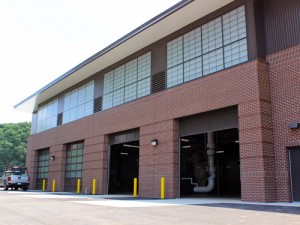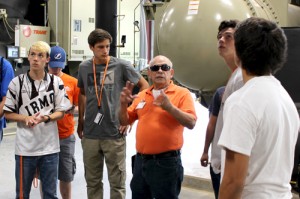
Clemson University’s main campus consists of roughly 165 buildings spread across 1,400 acres. Since 2008, the majority of these buildings’ air conditioning needs have been served from three on-campus chilled water facilities, known as the Central Energy Facility (CEF), the East Energy Plant, and the South (Hinson) Energy Plant. Chilled water, which helps cool a building’s overall temperature to a human comfort level, is pumped from these facilities to over 70 campus buildings through underground piping system often referred to as a chilled water loop.
With growing load demand, University Facilities’ Utility Services has constructed a fourth energy plant on the north side of the stadium, the West Energy Plant. Commissioned on June 2016, this facility increased Clemson’s chilled water (CHW) capacity by 3,000 cooling tons. There is space for an additional 3,000 tons of CHW capacity as well. For reference an average size 3 bedroom home in South Carolina will have a 3 ton air conditioning unit.
Existing Infrastructure

The Central chilled water loop combines the operations of the three interconnected chiller plants–the CEF, East and South–to efficiently serve the Central loop distribution system. The three Central chiller plants are designed for 11,400 tons of available capacity at a 12°F delta-T (40-52 ° F). In plain speak, the chilled water facilities connected to the Central loop send water to connected buildings at 40-degrees Fahrenheit and collectively receive the same water back at 52-degrees Fahrenheit, some 12-degrees warmer. More on this in a bit.
In terms of equipment, CEF has three 1,800 nominal-ton Trane duplex chillers which were installed in 1999, two of which rely on Lake Hartwell for lake water condenser cooling. The South (Hinson) Energy Plant has three 1,200 nominal-ton Trane chillers which were commissioned in 2008. The East Energy Plant originally built in 1986 was upgraded with two new 1,450 ton, variable speed drive Trane chillers in 2013. By moving to variable frequency drive chillers, the University is able to reduce its energy-consumption by optimizing control of the chiller plant’s operation to meet fluctuations in demand for air conditioning.
The New West Energy Plant

The new West Energy Plant has two 1,500 nominal-ton variable speed drive Trane chillers which together provide 3,000 tons of chill-water at 15°F delta-T (42-57 ° F). Chilled water system efficiency is tied to its delta-T, where in the higher the delta-T number, the more efficient the overall system can perform. This results in a decrease in the amount of electricity required to generate air conditioning for connected buildings while also amounting to cost savings for university operations. An efficient university central chilled water can provide cooling as much as 30 percent more efficient than a home air conditioning system.
Sufficient for Now, Prepared for the Future
With the new West Energy Plant, the total capacity of Clemson’s chilled water distribution system provides a peak system capacity of 13,100 cooling tons, with a current peak demand from connected buildings at about 11,300 cooling tons. That said, one only has to look in almost any direction to see that our cooling needs will be challenged with new campus construction. With the addition of the West Energy Plant, Clemson University is capable of meeting such demands for the foreseeable future.
